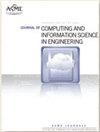下一代汽车系统设计:挑战与研究机遇
IF 3.3
3区 工程技术
Q2 COMPUTER SCIENCE, INTERDISCIPLINARY APPLICATIONS
Journal of Computing and Information Science in Engineering
Pub Date : 2023-07-31
DOI:10.1115/1.4063067
引用次数: 0
摘要
在“CASE”大趋势的推动下,汽车行业正在经历一场巨大的变革:互联、自动化、共享和电动化。这些趋势正在从内部和外部影响着汽车的特性。从内部来看,从内燃机(ICE)到电动传动系统的转变导致了从硬件定义车辆到软件定义车辆(sdv)的转变,其中软件正日益成为汽车价值链中的主导资产。这些趋势带来了新的设计挑战,例如如何管理不同的设计配置,如何将软件和服务的设计与硬件分离,以及如何设计硬件以允许升级。从外部看,汽车不再是孤立的产品。相反,它们是拥有云连接的更大数字生态系统的一部分。车辆使用数据越来越多地与智能工厂联系在一起,这为敏捷产品开发和大规模定制功能创造了新的机会。人类驾驶员的角色也在随着自动驾驶功能水平的提高而发生变化。在本文中,作者讨论了汽车行业正在进行的变革及其对工程设计的影响。本文提出了下一代汽车应用的工程设计研究路线图。本文章由计算机程序翻译,如有差异,请以英文原文为准。
Design of Next Generation Automotive Systems: Challenges and Research Opportunities
The automotive industry is undergoing a massive transformation, driven by the mega-trends of “CASE”: connected, automated, shared, and electric. These trends are affecting the nature of automobiles, both internally and externally. Internally, the transition from internal combustion engines (ICE) to electric drive-trains has resulted in a shift from hardware-defined vehicles to software-defined vehicles (SDVs), where software is increasingly becoming the dominant asset in the automotive value chain. These trends are leading to new design challenges such as how to manage different configurations of design, how to decouple the design of software and services from hardware, and how to design hardware to allow for upgrades. Externally, automobiles are no longer isolated products. Instead, they are part of the larger digital ecosystem with cloud connectivity. Vehicle usage data are increasingly connected with smart factories, which creates new opportunities for agile product development and mass customization of features. The role of the human driver is also changing with increasing levels of autonomy features. In this paper, the authors discuss the ongoing transformation in the automotive industry and its implications for engineering design. The paper presents a road map for engineering design research for next-generation automotive applications.
求助全文
通过发布文献求助,成功后即可免费获取论文全文。
去求助
来源期刊
CiteScore
6.30
自引率
12.90%
发文量
100
审稿时长
6 months
期刊介绍:
The ASME Journal of Computing and Information Science in Engineering (JCISE) publishes articles related to Algorithms, Computational Methods, Computing Infrastructure, Computer-Interpretable Representations, Human-Computer Interfaces, Information Science, and/or System Architectures that aim to improve some aspect of product and system lifecycle (e.g., design, manufacturing, operation, maintenance, disposal, recycling etc.). Applications considered in JCISE manuscripts should be relevant to the mechanical engineering discipline. Papers can be focused on fundamental research leading to new methods, or adaptation of existing methods for new applications.
Scope: Advanced Computing Infrastructure; Artificial Intelligence; Big Data and Analytics; Collaborative Design; Computer Aided Design; Computer Aided Engineering; Computer Aided Manufacturing; Computational Foundations for Additive Manufacturing; Computational Foundations for Engineering Optimization; Computational Geometry; Computational Metrology; Computational Synthesis; Conceptual Design; Cybermanufacturing; Cyber Physical Security for Factories; Cyber Physical System Design and Operation; Data-Driven Engineering Applications; Engineering Informatics; Geometric Reasoning; GPU Computing for Design and Manufacturing; Human Computer Interfaces/Interactions; Industrial Internet of Things; Knowledge Engineering; Information Management; Inverse Methods for Engineering Applications; Machine Learning for Engineering Applications; Manufacturing Planning; Manufacturing Automation; Model-based Systems Engineering; Multiphysics Modeling and Simulation; Multiscale Modeling and Simulation; Multidisciplinary Optimization; Physics-Based Simulations; Process Modeling for Engineering Applications; Qualification, Verification and Validation of Computational Models; Symbolic Computing for Engineering Applications; Tolerance Modeling; Topology and Shape Optimization; Virtual and Augmented Reality Environments; Virtual Prototyping

 求助内容:
求助内容: 应助结果提醒方式:
应助结果提醒方式:


